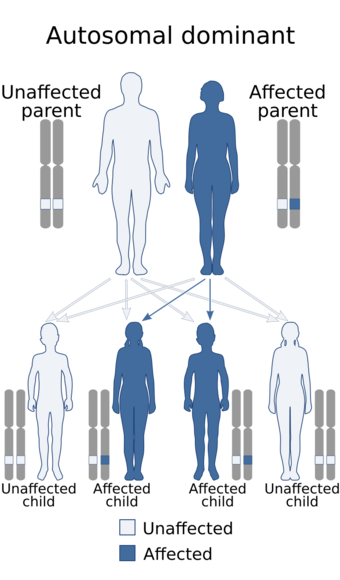Medicine:Weismann-Netter–Stuhl syndrome
| Weismann-Netter–Stuhl syndrome | |
|---|---|
| Other names | Weismann-Netter syndrome, tibioperoneal diaphyseal toxopachyosteosis |
 | |
| Weismann-Netter–Stuhl syndrome is inherited in an autosomal dominant manner. | |
Weismann-Netter–Stuhl syndrome, also known as Weismann-Netter syndrome or tibioperoneal diaphyseal toxopachyosteosis, is a rare disorder characterized by bowing of the lower legs and an abnormal thickening of thinner bone in the leg.[1]
The main sign is anterior bowing and posterior cortical thickening of the diaphyses of both the tibiae and fibulae. It is thought to be inherited in an autosomal dominant fashion and is most often bilateral and symmetric in nature. Associated features include dwarfism and mild intellectual disability as well as a process known as tibialization of the fibulae, which involves thickening and enlargement of these bones to an extent resembling the tibiae.[2] The combination of the presence of tibialization of the fibulae, which is highly specific for the disorder, and the absence of laboratory abnormalities, ruling out alternative diagnoses including rickets, essentially confirms the diagnosis.
Cause
This condition is currently felt to be a genetic disorder, caused by inheritance of an abnormal gene via autosomal dominant inheritance.[citation needed]
Diagnosis
Radiographic features
The most prominent and extensively documented findings of Weismann-Netter–Stuhl syndrome are on plain radiographs of the bones. Findings include bilateral and symmetric anterior bowing of both tibiae and fibulae, lateral bowing of the tibiae, femoral bowing, and squaring of iliac and pelvis bones.[3]
Management
Gene therapy if possible
This section is empty. You can help by adding to it. (August 2017) |
History
The features of this disorder were first described by French doctors Robert Weismann-Netter (1894–1980)[4] and L. Stuhl in their report first describing the association in seven patients in 1954.[5] They believed these seven patients had mistakenly been diagnosed as congenital syphilis or rickets, which remain the primary considerations in the differential diagnosis of this syndrome today.[citation needed]
References
- ↑ Gupta, P.; Mittal, R.; Mittal, S.; Shankar, V. (2014). "Weismann-Netter-Stuhl syndrome: report of two cases and treatment". Case Reports 2014 (feb04 2): bcr2013201772. doi:10.1136/bcr-2013-201772. ISSN 1757-790X. PMID 24496066.
- ↑ Robinow, M.; Johnson, G. F. (March 1988). "The Weismann-Netter syndrome". American Journal of Medical Genetics 29 (3): 573–579. doi:10.1002/ajmg.1320290315. ISSN 0148-7299. PMID 3377000.
- ↑ Peippo, Maarit; Valanne, Leena; Perhomaa, Marja; Toivanen, Leena; Ignatius, Jaakko (November 2009). "Weismann-Netter syndrome and mental retardation: a new patient and review of the literature". American Journal of Medical Genetics. Part A 149A (11): 2593–2601. doi:10.1002/ajmg.a.33019. ISSN 1552-4833. PMID 19839038.
- ↑ Beighton, Peter; Beighton, Greta (2012-12-06) (in en). The Man Behind the Syndrome. Springer Science & Business Media. pp. 231. ISBN 978-1-4471-1415-4. https://books.google.com/books?id=-TGgBQAAQBAJ&pg=PA231.
- ↑ Weismann-Netter, R.; Stuhl, L. (1954-11-24). "[Congenital osteopathy eventually familial defined especially by antero-posterior incurvation and thickening of both bones of the leg: diaphyseal tibio-peroneal toxopachyostosis]". La Presse Médicale 62 (78): 1618–1622. ISSN 0032-7867. PMID 13237064.
External links
| Classification | |
|---|---|
| External resources |
 |

